Tritton’s rival
In 1917, Sir William Tritton was working with Major Gordon Wilson to produce the Mark A “Whippet”, the first British light/cavalry tank. It’s replacement was already being planned in 1918. However, relationships between Tritton and Wilson deteriorated to such an extent that the latter launched his own project (which became the Medium Mark B). As soon as he heard of it, Wilson, under the guidance of his chief engineer, William Rigby, designed a rival project, which would become the Medium Mark C.
Development of the Mark C
Tritton’s own project had been developed at breakneck speed. On 19 April 1918, the general blueprints were ready and had been approved by the British Army. In August 1918, the first prototype was finished and ready for trials, trying to catch up with the Medium Mark B construction. A first order rapidly came for 200, later augmented to 600, when it became apparent that Wilson’s Mark B could not fulfill its requirements. The Mark C was to be manufactured at William Foster & Co Ltd at Lincoln, Armlet & Wortley joining in as a subcontractor. Like the Mark B, it was to be unofficially dubbed “Hornet”. However, the war ceased just as production started, and the order was cancelled after just 36 tanks were built. With the remaining parts, another batch of 14 was manufactured in 1919, giving a a total of 50.
Design
The Mark C resembled the Mark B in many ways and both differed from the previous Mark A by having their main superstructure shifted to the front. Other than that, both had the same classic rhomboid chassis shape, although both were higher than the Whippet, and they had the same engine, a Ricardo 6-cyl petrol, which developed 150 hp. It was housed in a rear separate engine compartment behind a standard epicyclic transmission in the middle section, with the radiators above, and two rear exhaust pipes and silencers running along the rear section. The engine was still easily accessible from the crew compartment. The main 150 imp gal (680 l) petrol tank was located in the rear section. The tank had about 225 km (140 mi) of range, much better than any previous model. With a power-to-weight of 7.5 hp/tonne, to speed was around 12.7 km/h (8 mph), which was slightly less than the Mark A. But with 20 tonnes versus 14, it was understandable. Armour was about 13 mm (0.51 in).
The driver-compartment comprised the driver’s seat and ammo storage for the machine-guns. The rest of the crew was located in the casemate, which was given four ball mounts, covering all angles. The driver had his own small cabin/lookout door, protruding from the front casemate, with three sight slits and an odometer. The armament comprised between two and five Hotchkiss M1909 machine-guns. Five were usually supplied, but when less were installed they were switched between positions as needed. Only the limited interior space prevented to use of all five at once, and in practice it rarely exceeded three. The commander had his own special revolving lookout turret and small map table. The former was located above the rear section of the casemate. Interestingly enough, there was a Chappe type signal arm just behind it, to communicate between tanks. Vision was good, with as much as 11 sight slits covering all angles. The crew’s own gear was safe in internal stowage boxes and there were even speaking tubes to facilitate internal communication.
Like other rrhomboid tanks, the wheel train counted multiple small roadwheels with an unsprung suspension. The track adjusting idlers were located at the front, and drive sprocket at the rear.
Active service
The Mark C, despite being late in the game, was quickly preferred over the Mark B. It was planned for the great spring offensive of 1919, for which the Tank Corps should have optimistically received 6,000 Medium C, a third of which were to be of the “Male” version, receiving the long six-pounder gun in the casemate’s front. The drawings of this version were ready when the war was over. The only units receiving the new tank after the war was the 2nd Tank Battalion. None were sent in foreign expeditions and they were kept in service until their replacement by the more modern Medium Mark I/II of 1926-28. Their only “military” action occurred when trying to contain labour unrest in Glasgow (“Battle of George Square”, 1919).
Links
The Medium Mark C on wikipedia
On landships II
Mark C specifications |
|
| Dimensions | 7.9 x2.5 x2.9 m (25.10 x8.1 x9.6 ft) |
| Total weight, battle ready | 20 tons (40,000 lbs) |
| Crew | 4 (driver, commander, mechanic, machine-gunner) |
| Propulsion | Ricardo 6-cyl petrol, 150 hp, 7.5 hp/tonne |
| Suspension | Unsprung |
| Speed (road) | 12.7 km/h (8 mph) |
| Range | 225 km (140 mi) |
| Armament | 5x 0.303 in (7.7 mm) machine-guns |
| Armor | 13 mm front (0.31 in) |
| Total production | 45 in 1919 |
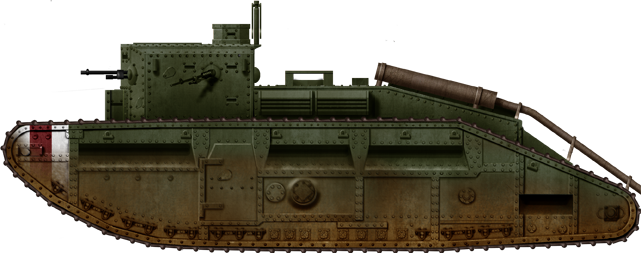
Medium Mark C, standard livery 1919.
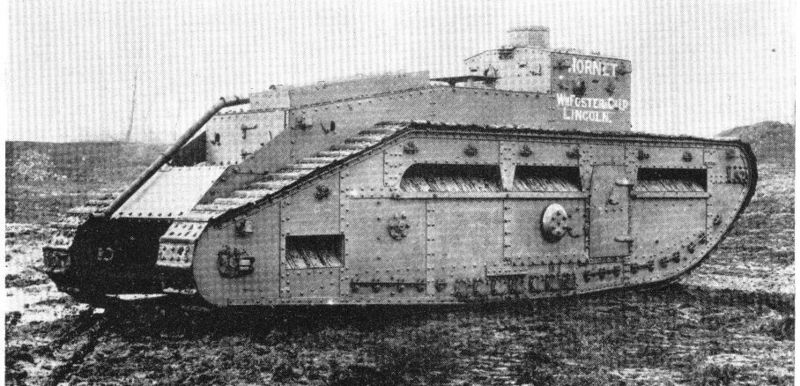
Medium Mark C, rear view.
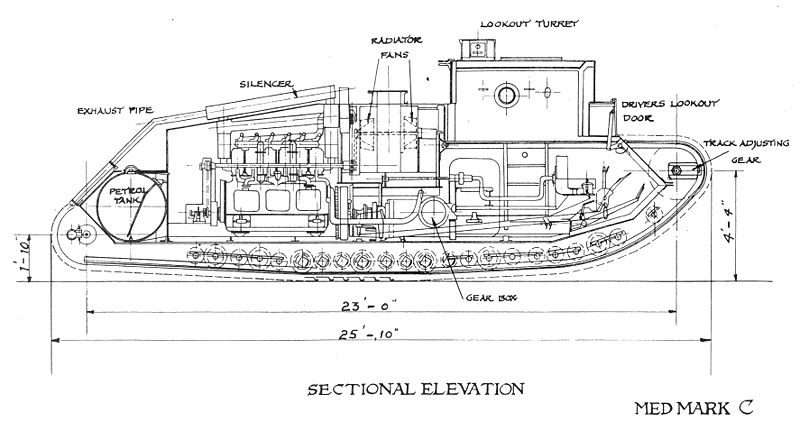
A schematic of the interior.
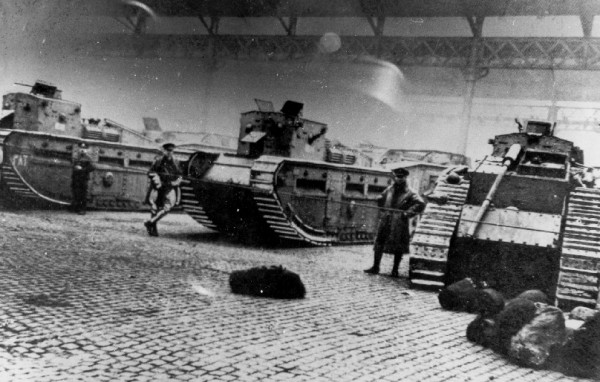
Medium Mark C at the Battle of George Square during the labor riots of Glasgow, 1919.
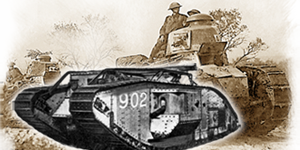
The Great War
 Austria-Hungary
Austria-Hungary Belgium
Belgium British Empire
British Empire France
France German Empire
German Empire Italy
Italy Russia
Russia USA
USAWW1 tanks posters

